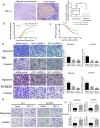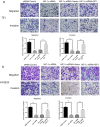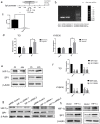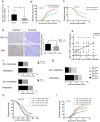HIF-1α Promotes the Metastasis of Esophageal Squamous Cell Carcinoma by Targeting SP1
- PMID: 31892989
- PMCID: PMC6930417
- DOI: 10.7150/jca.35537
HIF-1α Promotes the Metastasis of Esophageal Squamous Cell Carcinoma by Targeting SP1
Abstract
Background: In microenvironment of malignant tumors, Hypoxia-Inducible Factors (HIF), most importantly HIF-1α, play an important role in regulation of adaptive biological response to hypoxia, promoting angiogenesis and metastasis. However, the underlying mechanism that HIF-1α regulates metastasis needs to be further clarified. Methods: The expressions of HIF-1α and SP1 were detected in 182 samples of esophageal squamous cell carcinoma (ESCC) and adjacent normal tissues by immunohistochemistry (IHC), and the correlation between the expression levels of HIF-1α and SP1 was analyzed. The expression of HIF-1α in ESCC cell lines TE1 and KYSE30 was then detected using qRT-PCR and western blot. The potential binding sites of HIF-1α on the SP1 promoter were analyzed using UCSC and JASPAR databases, verified by chromosomal immunoprecipitation (ChIP) assay and qRT-PCR. The effects of HIF-1α and SP1 on ESCC cell migration and invasion were then tested with Transwell and Matrigel experiments. Results: The expression of HIF-1α in cancer tissues is higher than adjacent normal tissues, and is correlated with metastasis, recurrence and poor prognosis. Upon silencing HIF-1α by siRNA, the invasion and migration ability of ESCC cells were significantly inhibited, which could be restored by the overexpression of SP1. Hypoxic conditions significantly increased the expression of HIF-1α and SP1 at both protein and mRNA levels in ESCC cells. HIF-1α enhanced SP1 transcription through binding to the promoter region. The expression of protein and mRNA levels of SP1 was decreased by silencing HIF-1α in cells. In contrast, overexpression of HIF-1α significantly increased the mRNA and protein levels of SP1. The expression of SP1 in ESCC was positively correlated with the protein expression of HIF-1α and poor prognosis. Conclusion: The results of our study indicate that HIF-1α promotes metastasis of ESCC by targeting SP1 in a hypoxic microenvironment. Further study on this mechanism may elucidate the possibility of HIF-1α and SP1 as new targets for the treatment of ESCC.
Keywords: ESCC; HIF-1α; SP1; tumor metastasis.
© The author(s).
Conflict of interest statement
Competing Interests: The authors have declared that no competing interest exists.
Figures




Similar articles
-
CCL21-CCR7 promotes the lymph node metastasis of esophageal squamous cell carcinoma by up-regulating MUC1.J Exp Clin Cancer Res. 2015 Dec 15;34:149. doi: 10.1186/s13046-015-0268-9. J Exp Clin Cancer Res. 2015. PMID: 26667143 Free PMC article.
-
Hypoxia disrupt tight junctions and promote metastasis of oral squamous cell carcinoma via loss of par3.Cancer Cell Int. 2023 Apr 24;23(1):79. doi: 10.1186/s12935-023-02924-8. Cancer Cell Int. 2023. PMID: 37095487 Free PMC article.
-
DNA polymerase iota promotes EMT and metastasis of esophageal squamous cell carcinoma by interacting with USP7 to stabilize HIF-1α.Cell Death Dis. 2024 Feb 24;15(2):171. doi: 10.1038/s41419-024-06552-6. Cell Death Dis. 2024. PMID: 38402183 Free PMC article.
-
Prognostic values of STAT3 and HIF-1α in esophageal squamous cell carcinoma.Eur Rev Med Pharmacol Sci. 2019 Apr;23(8):3351-3357. doi: 10.26355/eurrev_201904_17698. Eur Rev Med Pharmacol Sci. 2019. PMID: 31081089
-
Interaction and Collaboration of SP1, HIF-1, and MYC in Regulating the Expression of Cancer-Related Genes to Further Enhance Anticancer Drug Development.Curr Issues Mol Biol. 2023 Nov 17;45(11):9262-9283. doi: 10.3390/cimb45110580. Curr Issues Mol Biol. 2023. PMID: 37998757 Free PMC article. Review.
Cited by
-
Association of Nuclear Receptor Coactivators with Hypoxia-Inducible Factor-1α in the Serum of Patients with Chronic Kidney Disease.Biomed Res Int. 2020 Aug 20;2020:1587915. doi: 10.1155/2020/1587915. eCollection 2020. Biomed Res Int. 2020. PMID: 32884936 Free PMC article. Clinical Trial.
-
Esophageal Microenvironment: From Precursor Microenvironment to Premetastatic Niche.Cancer Manag Res. 2020 Jul 16;12:5857-5879. doi: 10.2147/CMAR.S258215. eCollection 2020. Cancer Manag Res. 2020. PMID: 32765088 Free PMC article. Review.
-
An N-glycoproteomic site-mapping analysis reveals glycoprotein alterations in esophageal squamous cell carcinoma.J Transl Med. 2022 Jun 25;20(1):285. doi: 10.1186/s12967-022-03489-2. J Transl Med. 2022. PMID: 35752862 Free PMC article.
-
SP1 Expression and the Clinicopathological Features of Tumors: A Meta-Analysis and Bioinformatics Analysis.Pathol Oncol Res. 2021 Jan 28;27:581998. doi: 10.3389/pore.2021.581998. eCollection 2021. Pathol Oncol Res. 2021. PMID: 34257529 Free PMC article.
-
Cartilage Endplate Stem Cells Transdifferentiate Into Nucleus Pulposus Cells via Autocrine Exosomes.Front Cell Dev Biol. 2021 Mar 4;9:648201. doi: 10.3389/fcell.2021.648201. eCollection 2021. Front Cell Dev Biol. 2021. PMID: 33748142 Free PMC article.
References
-
- Fitzmaurice C, Allen C, Barber RM. et al. Global, regional, and national cancer incidence, mortality, years of life lost, years lived with disability, and disability-adjusted life-years for 32 cancer groups, 1990 to 2015: a systematic analysis for the global burden of disease study. JAMA Oncol. 2017;3:524–8. - PMC - PubMed
-
- Torre LA, Bray F, Siegel RL. et al. Global cancer statistics, 2012. CA Cancer J Clin. 2015;65:87–108. - PubMed
-
- Sjoquist KM, Burmeister BH, Smithers BM. et al. Survival after neoadjuvant chemotherapy or chemoradiotherapy for resectable oesophageal carcinoma: an updated meta-analysis. Lancet Oncol. 2011;12:681–92. - PubMed
-
- Fakhrian K, Ordu AD, Lordick F. et al. Long-term outcomes of trimodality treatment for squamous cell carcinoma of the esophagus with cisplatin and/or 5-FU. StrahlentherOnkol. 2014;190:1133–40. - PubMed
-
- Mariette C, Piessen G, Triboulet JP. Therapeutic strategies in oesophageal carcinoma: Role of surgery and other modalities. The Lancet Oncology. 2007;8:545–53. - PubMed
LinkOut - more resources
Full Text Sources

